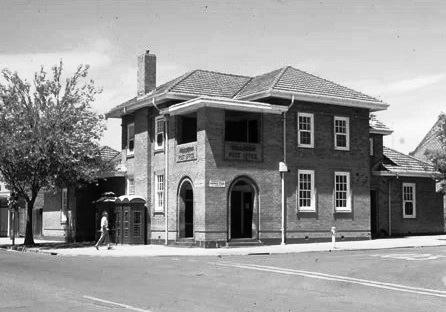Educational needs were recognized as early as 12 February, 1922 when the Yallourn State School No 4085 was opened with 13 pupils. The first school building was a weatherboard cottage at No4 Hillside. By 1923 enrolment had reached 139 pupils - they came from the Camps and outlying areas, so a move to new and bigger buildings in Outlook Road was needed. This would become the Secondary School when a new Primary school was opened in 1932, on the corner of Fairfield Avenue and Banksia Crescent. A Catholic Primary School had also opened in the St Therese’s church hall staffed by two sisters of St Joseph.
1926 saw the Post Office and State Savings Bank opened for business - they occupied corresponding sites on opposite sides of the town square and were complementary in design. They were double-storied, the upper storeys were residences for the bank manager and postmaster. Prior to the opening of the town post office, postal facilities had operated at Eastern and Western Camps. The Yallourn Post Office closed for business on 31/1/1980.
Yallourn Railway line was opened in 1922 as a branch line headed north from the main Gippsland line, built to transport goods to and from the Power Station and Briquette Factory. People would often walk the line collecting the briquettes that had fallen from the wagons. They would use the briquettes to heat their homes during the winter. In 1954 Queen Elizabeth II visited the valley she arrived at Yallourn by train on the original Hernes Oak loop line. By 1955 a new line was constructed from Moe as the old Hernes Oak line was taken out of service due to the expansion of the open cut when the main line to Melbourne was completed. The old route via Hernes Oak was initially retained with empty trains, using it with loaded trains using the new line to return to Melbourne. A new signal box at Yallourn marshaling yard was opened in December 1955, allowing two way operation on the new line, the old line falling into disuse but not removed until March 1957, when the SECV begun to expand the Yallourn open cut mine across the alignment. At the Hernes Oak end, part of the former line was retained as a dead end siding. Despite the expansion of the mine, briquette traffic began to decline, with power generation at Yallourn growing in demand instead. Due to the decrease in railway traffic the signal box and interlocking at Yallourn was removed in May 1968, and in April 1974 the substation was taken out of use, overhead power being fed from Moe. In October 1978 electric trains were banned from the line, and in March 1979 work began on removing the overhead wiring . The railway station in Yallourn was not a regular passenger line and was only used on special occasions and for school excursions. The line from Moe is now part of the Moe to Yallourn rail trail, constructed in the 1990s, which starts at the Botanic Gardens in Moe and takes a leisurely 8km trail to the Yallourn W Power Station.
In 1928 Volunteers would begin work on draining the “Melbourne Swamp” to create the sporting ovals. These ovals would later be classed as among the best in the state. In 1955, the touring MCC team played for three days on one of the manicured ovals and in 1956, 13,000 people turned up to see international athletes stage a mini Olympics. In November 1971 No 1 oval flooded enough for Dan Suckling and Ross Simpson to take their boat and water ski on it. The oval was drained in time for the next football match to be played on it.
No 1 Oval Flooded - Don Suckling & Ross Simpson - Nov 1971
In 1928, volunteers began work on draining the "Melbourne Swamp" to create the sporting ovals. These ovals would later be classed as among the best in the State.
In 1955, the touring MCC team played for 3 days on one of the manicured ovals and in 1956, 13,000 people turned up to see international athletes stage a "mini Olympics".
In November 1971, No 1 oval flooded enough for Don Suckling and Ross Simpson to take their boat and water-ski on it. The oval was drained in time for the next football match to be played on it.
Yallourn Primary School YPS 4085 - bordering Park Cres, Banksia Cres & Fairfield Ave
Educational needs were recognised as early as 12 February, 1922 when the Yallourn State School No 4085 was opened with 13 pupils. The first school building was a weatherboard cottage at No.4 Hillside. By 1923 enrolment had reached 139 pupils, they came from the Camps and outlying areas, so a move to a new and bigger buildings in Outlook Road was needed. This would become the Secondary School when a new Primary school was opened in 1932, bordering Park Crescent, Banksia Crescent and Fairfield Avenue.
A Catholic Primary School had also opened in the St Therese’s church hall staffed by two sisters of St Joseph.
Yallourn Primary School YPS First No 4 Hillside - 1922
On 12 February 1922 the Yallourn State School No 4085 was opened with 13 pupils. The first school building was a weatherboard cottage at No 4 Hillside. By 1923, enrolment had reached 139 pupils; they came from the Camps and outlying areas, so a move to new and bigger buildings in Outlook Road was needed. This would become the Secondary School when a new Primary school was opened in 1932, on the corner of Fairfield Avenue and Banksia Crescent.








The little building next to
The little building next to clubhouse was the timekeepers box. It also doubled as the scorers room in cricket season. The main scoreboard was almost directly opposite on the right of the main entry gate as you looked from clubhouse. I remember many a great day when my mate and I would sell "Followers" (the footy program for the LVFL) at the gate from opening time till about midday then one of us would head over to scoreboard to man it. We would both or all be there by about three quarter time in the seconds game and follow the scores intensely in the main game, doing our best to keep it accurate. It had those fabulous old rollers that sent the numb ers spinning after a goal or behiind was scored.
I also remember the legendary goal umpire David Drane who was one of a kind. Mr Perfection. He would always signal to us if we had missed something and would confirm our scoreboard at the end of each quarter. I could be wrong but I think he might have goal umpired both games on many a Saturday. For many kids it was a bit of an honour to sit on the edge of the scoreboard with legs swinging and getting a great view of No. 1 oval. The only "rule" was not to stand up in case someone's view of the scores was blocked............ great days.
The top photo is accurate, the bottom one is reversed. Timekeepers box was on right of clubrooms as you looked at it.